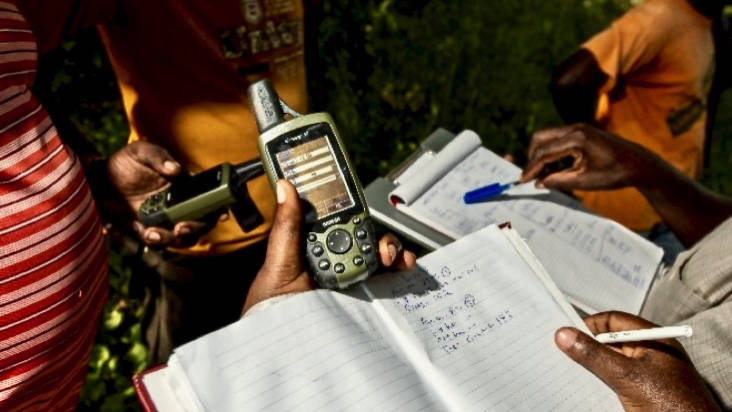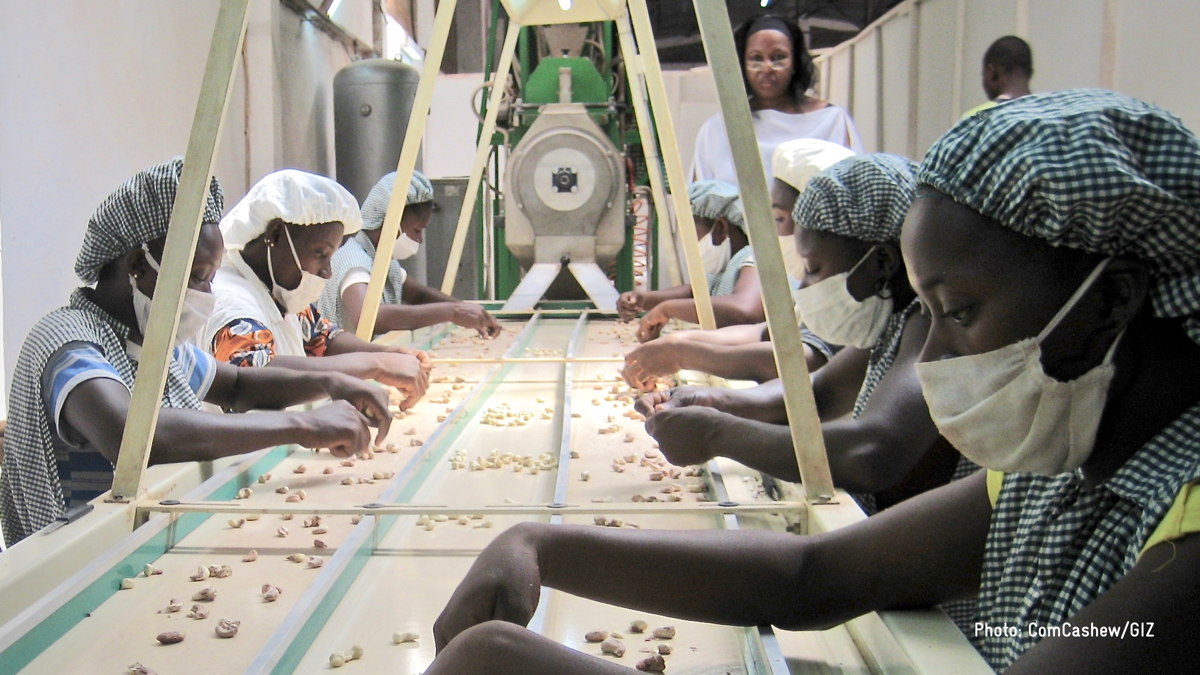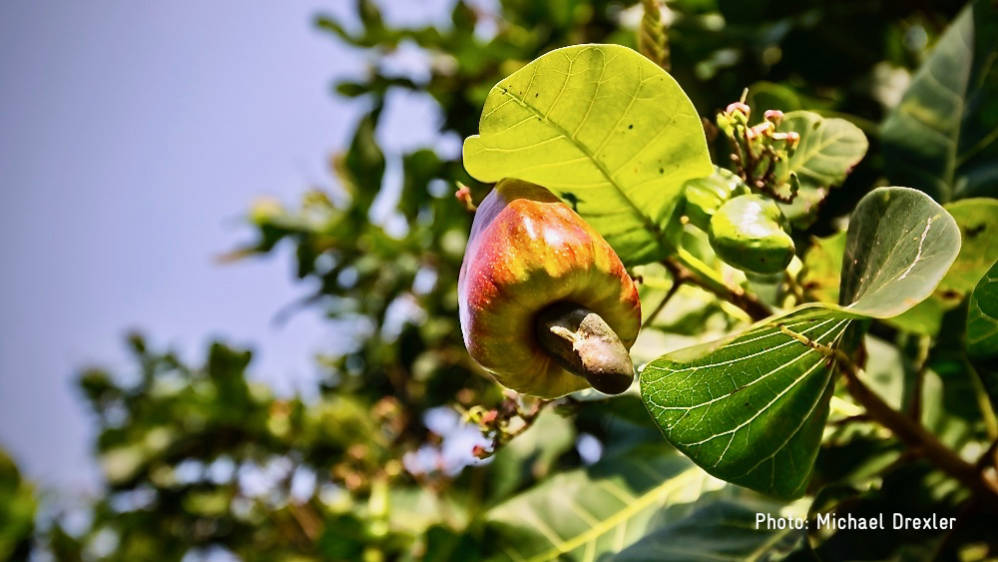Innovation Transforms the Cashew Sector
How digital solutions contribute to a competitive value chain
SAP Rural Sourcing Management
© GIZ/ComCashew
In relation to the cashew sector, so far technical and digital innovations have contributed to change the way cashew is traced, analysed and communicated. New technologies support the digitalisation of knowledge in the sector, that is to make information available and to ensure transparent sourcing and supply. A competitive value chain is typically characterized by fair supply chains and ensuring traceability of cashew nuts is one of the drivers that will keep the cashew sector viable globally. In this context innovative technologies have been developed and tested. They show great potential to support agribusinesses in their efforts to onboard farmers, document farm compliance with standards, and track produce across the value chain.
For instance in 2010, SAP partnered with GIZ/ComCashew — then known as ACi — to develop an innovative mobile application for the digital inclusion of small-scale farmers. The initial project saw a Rural Sourcing Management prototype implemented in Ghana and Burkina Faso. This helped to improve farmer incomes and livelihoods, advancing African cashew nut quality and production, increasing local processing capacity while improving market linkages along the value chain.
SAP Rural Sourcing Management supports the connection of smallholder farmers in developing countries with global producers — providing transparency, accountability and access to financial services. The tool has been developed further and is in use in Uganda currently, generating additional prospects in the tree crops sector.
Ten years on, ComCashew still focuses on sustainable supply and wants to contribute to development of new innovative approaches. Among this is an ongoing collaboration with the Sustainable Nut Initiative (SNI). With regards to the cashew value chain, SNI focuses on improving transparency in order to achieve secure supply, reach higher quality and work towards sustainability. This has resulted in the creation of the Securing Sustainable Supply software system (3S), which allows buying companies to make informed decisions about their supply base and facilitates the exchange of data between different links in the supply chain.

GPS—Geographic Positioning Systems
© GIZ/ComCashew
Communicate and conserve — How to manage increasing quantity and quality of cashew data
An important benefit of the use of digital solutions in the sector is to improve access to market information. Therefore, ComCashew partners strongly with the African Cashew Alliance (ACA) which has since 2006 been the umbrella association for farmers, processors, traders and cashew associations across Africa and throughout the world.
The association has developed the ACA Market Information System which was introduced to provide information on market trends in cashew producing countries. Seasonal updates on production, raw cashew nut and kernel prices are shared through an online database and weekly market analysis.
Today, there are broader innovative digital solutions that go further than just facilitating market information and communication – there is a shift from just using digital solutions to communicate or disseminate information to true digitalization.
Such digital solutions among other things make it possible to digitize and to conserve existing technical and institutional knowledge. A pioneer work is done under the GIZ/ComCashew EU project Resilience Against Climate Change in Savanah ecological zones in Ghana. In this context, the project intends to establish a Digital Library that will provide a database for the management of project data, research and agricultural data, held by local partners to support planning and coordination. This Technical instrument will serve as a repository of documents for saving physical and digital documents and making it accessible to the public. According to the lead Technical Consultant Karl Tiller, this “represents a unique chance to preserve existing knowledge”.

Peeling and sorting of processed kernels
Looking to the future
As demonstrated, digital innovations can be a game changer for the cashew sector and the presented examples show how digital solutions were and are used by ComCashew and its partners. In the cashew sector, the quantity and quality of data is growing and new digital tools make it possible to capture data from individual farms to international traders, combine data on macro levels and use this to improve the overall value chain. The above experiences are but a few examples of how digital solutions can be used. Opportunities in data management systems, GPS Mapping and geotracking, drone use (for farm monitoring, pest and disease management etc.), digital financial services such as mobile payment systems, digital advisory and information services (for example on GAP or harvest and post-harvest practices) and many more still remain unexploited in the cashew sector.The Technical Center for Agricultural and Rural Cooperation (CTA) reiterates in its Report on Digitalisation of Agriculture in Africa 2018-19 that “an inclusive, digitally-enabled agricultural transformation could help achieve meaningful livelihood improvements for Africa’s 250 million smallholder farmers and pastoralists”. In order to fully benefit from these prospects particularly in the cashew producing countries, investments in research and dissemination of new digital innovations need to be scaled up. This includes a focus on human capacity development, in order to improve digital literacy and make sure that stakeholders in the value chain understand how to best use and deploy digital solutions.

Originally introduced in Africa to combat desertification
Within the last 10 years cashew has proven to be able to creat great economic value for the continent. The share of African cashew already exceeds half of the global production and this trend continues to rise while production in Southeast Asia and in Brazil dwindles. Nevertheless, the increase is still far from meeting the demand for cashew nuts on the world market, increasing by around 6-7% annually. Today, most African countries face the challenge of making the cashew sector sustainable.
However, in order to make the cashew sector and agriculture in general fit for the future, several African governments have committed to making agricultural transformation through digital solutions and technical innovations an important policy priority in order to meet the challenges of food and nutrition insecurity, climate change, youth unemployment and overall economic growth.
Technologies can help stimulate innovation for sustainable agri-food systems and produce better and safer food while preserving natural resources and biodiversity. But we need to be conscious and support solutions that are sustainable and that are tailored to countries’ needs and embedded into conducive and broader innovation systems.
Authors
The text was provided by Maria Schmidt, Advisor, Sector Organisation and Julius Abila Abagi, Communication Officer, GIZ/ComCashew

